The Endocrine System
1/84
Earn XP
Description and Tags
Chapter 9
Name | Mastery | Learn | Test | Matching | Spaced |
|---|
No study sessions yet.
85 Terms
9.1 - The Glands and Hormones of the Endocrine System
Endocrine System
Composed of hormone-producing glands and tissues of the body
Works with nervous system to monitor and respond to body’s changing internal environment
Functions: control of heart rate, growth/development, blood pressure. rate of metabolism, immune response to infection, reproduction, response to stress
Slower and longer acting effects compared to the nervous system
Endocrine Glands
Secrete chemical messengers (hormones) into the bloodstream and are transported throughout the body
Glands that function exclusively as endocrine glands: pituitary, pineal, thyroid, parathyroid and adrenal glands
Glands with other functions: hypothalamus, thymus, pancreas, testes and ovaries
Diagram of glands
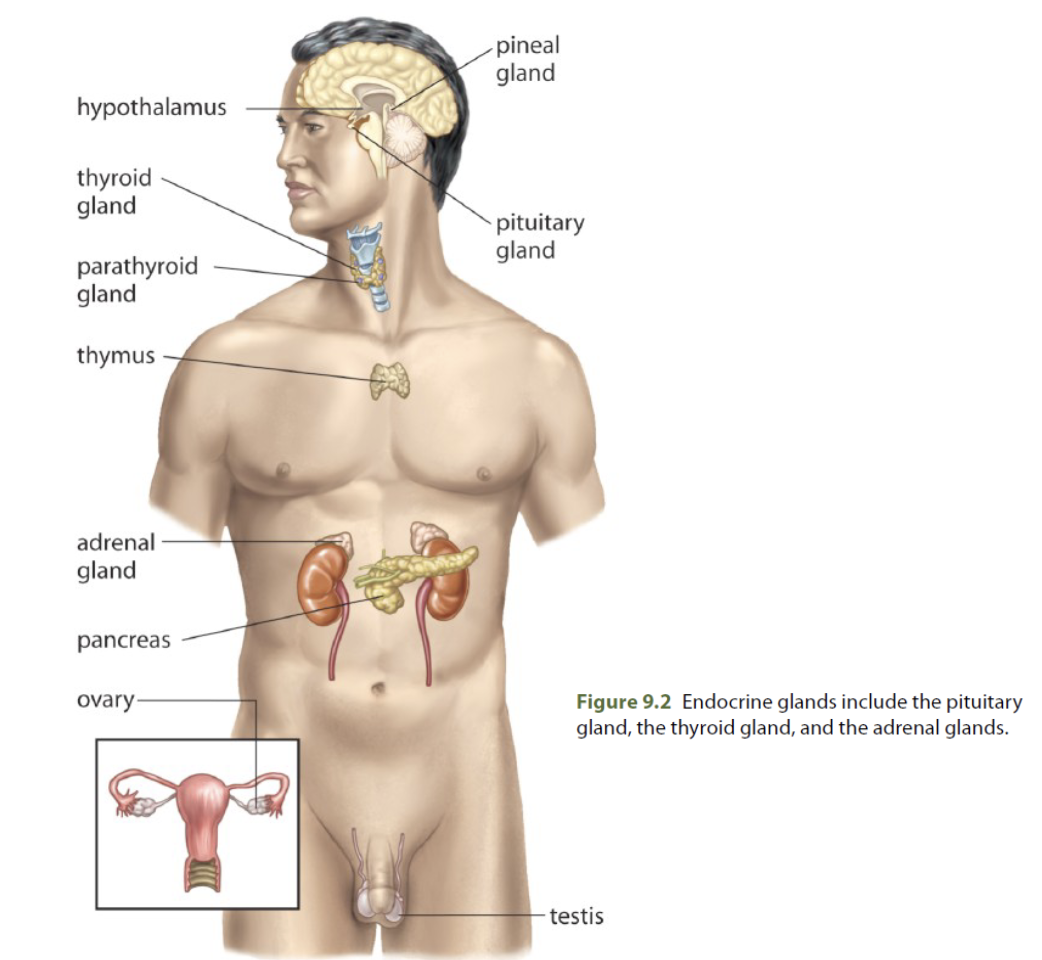
Hormone
Chemical messenger that circulates through blood and exerts control or effect on target cels, tissues or organs
Secreted in small amounts
Over 200 hormones in the human body
Hormone Action on Target Cells
A hormone targets a specific cell by binding to specific receptor proteins (lock-and-key fit)
• The target cell receives and responds to the chemical message sent by the hormone
Steroid Hormones
e.g. cortisol, testosterone, estrogen
Lipid-based (hydrophobic): must combine with a protein carrier that transports them through bloodstream
can diffuse through cell membrane
In target cell they bind to a protein receptor molecule in nucleus
Hormone-receptor complex activates a gene and synthesis of a specific mRNA molecule
mRNA moves into cytoplasm for protein synthesis
Steroid Hormones
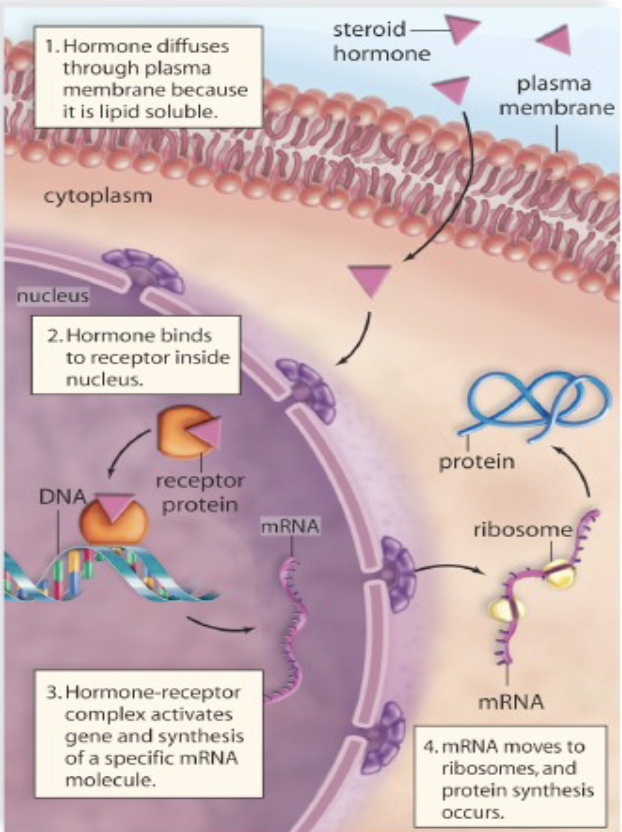
Water-Soluble Hormones
e.g. epinephrine, hGH, thyroxine (T4), insulin
Made of amino acids
Cannot diffuse across cell membrane (large and polar)
Binds to a receptor protein on the surface of a target cell
Causes cascade of reactions within target cell
Each reactions triggers many other reactions - impact of hormone is amplified
One hormone can trigger release of hundreds of other molecules
Water-soluble Hormones
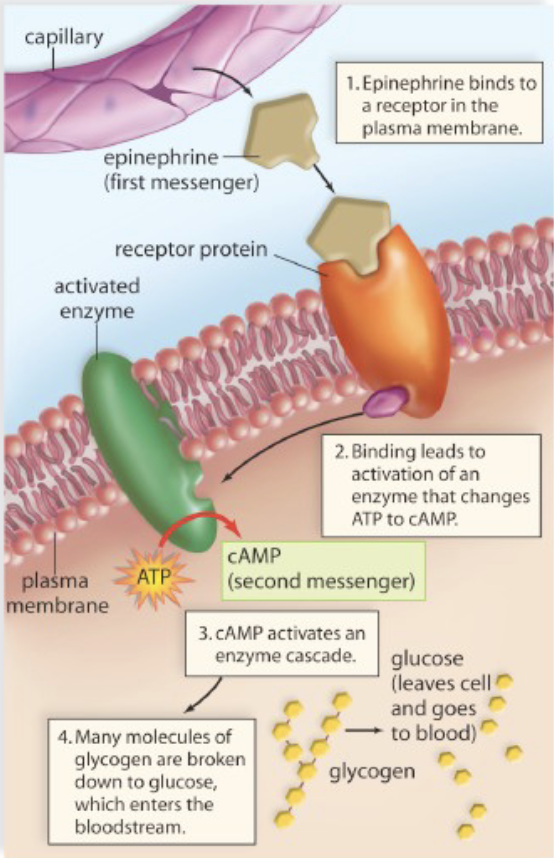
Regulating the Regulators
Hypothalamus receives sensory info from nervous system
Hypothalamus controls pituitary gland which produces hormones that stimulate endocrine glands in the body.
Hormones that targets endocrine glands and stimulates them to release other hormones are tropic hormones. Hormones released from the Hypothalamus and Pituitary Gland are these types of hormones.
Regulation through negative feedback loops

Relationship between the Endocrine and Nervous System
Hypothalamus: part of nervous system but also secretes hormones
Some neurotransmitters are also hormones (eg. Epinephrine)
Both systems are regulated by feedback loops
Some physiological processes require both systems to work together. For example; lactation - sensory message in the neurons travels to hypothalamus, triggering the release of the hormone oxytocin, which travels through the bloodstream to the mammary glands, causing milk secretion
Hormones and their effect: Hypothalamus
Hormone Secreted: hypothalamic releasing and inhibiting hormones
Effect on target tissues/organs: regulates anterior pituitary hormones
Hormones and their effect: Anterior pituitary
Hormone secreted: Human growth hormone (hGH)
Effect on target tissues/organs: stimulates cell division, bone and muscle growth and metabolic functions
Hormones and their effect: Anterior pituitary
Hormone secreted: Thyroid-stimulating hormone (TSH)
Effect on target tissues/organs: Stimulates the thyroid gland
Hormones and their effect: Anterior pituitary
Hormone secreted: Adrenocorticotropic hormone
Effect on target tissues/organs: Stimulates the adrenal cortex to secrete glucocorticoids
Hormones and their effect: Anterior pituitary
Hormone secreted: Follicle-stimulating hormone (FSH)
Effect on target tissues/organs: Stimulates production of ova and sperm from the ovaries and testes
Hormones and their effect: Anterior pituitary
Hormone secreted: Luteinizing hormone (LH)
Effect on target tissues/organs: Stimulates sex hormone production from the ovaries and testes
Hormones and their effect: Anterior pituitary
Hormone secreted: Prolactin (PRL)
Effect on target tissues/organs: Stimulates milk production from the mammary glands
Hormones and their effect: Posterior pituitary
Hormone secreted: Antidiuretic hormone (ADH)
Effect on target tissues/organs: Promotes the retention of water by the kidneys
Hormones and their effect: Posterior pituitary
Hormone secreted: Oxytocin (OCT)
Effect on target tissues/organs: Stimulates uterine muscle contractions and release of milk by the mammary glands
Hormones and their effect: Thyroid
Hormone secreted: Thyroxine (T4)
Effect on target tissues/organs: Affects all tissues; increases metabolic rate and regulates growth and development
Hormones and their effect: Thyroid
Hormone secreted: Calcitonin
Effect on target tissues/organs: Targets bones and kidneys to lower blood calcium by inhibiting release of calcium from bone and reabsorption of calcium by kidneys
Hormones and their effect: Parathyroid
Hormone secreted: Parathyroid hormone (PTH)
Effect on target tissues/organs: Raises blood calcium levels by stimulating the bone cells to release calcium, the intestine to absorb ca
Hormones and their effect: Adrenal Cortex
Hormone secreted: Glucocorticoids (for example, cortisol)
Effect on target tissues/organs: Stimulates tissues to raise blood glucose and break down protein
Hormones and their effect: Adrenal Cortex
Hormone secreted: Mineralocorticoids (for example,
aldosterone)
Effect on target tissues/organs: Promotes reabsorption of sodium and water by the kidneys
Hormones and their effect: Adrenal Cortex
Hormone secreted: Gonadocorticoids
Effect on target tissues/organs: Promotes secondary sexual characteristics
Hormones and their effect: Adrenal Medulla
Hormone secreted: Epinephrine and norepinephrine
Effect on target tissues/organs: Fight-or-flight hormones
Hormones and their effect: Pancreas
Hormone secreted: Insulin
Effect on target tissues/organs: Lowers blood glucose levels and promotes the formation of glycogen in the liver
Hormones and their effect: Pancreas
Hormone secreted: Glucagon
Effect on target tissues/organs: Raises blood glucose levels by converting glycogen in the liver to glucose
Hormones and their effect: Ovaries
Hormone secreted: Estrogen
Effect on target tissues/organs: Stimulates uterine lining growth and promotes development of the female secondary sexual characteristics
Hormones and their effect: Ovaries
Hormone secreted: Progesterone
Effect on target tissues/organs: Promotes growth of the uterine lining and prevents uterine muscle contractions
Hormones and their effect: Testes
Hormone secreted: Testosterone
Effect on target tissues/organs: Promotes sperm formation and development of the male secondary sexual characteristics
9.2 Hormonal Regulation of Growth, Development, and Metabolism
Hypothalamus
Regulates body’s internal environment to maintain homeostasis
Responds to body signals like temperature, hunger, thirst, blood pressure, stress, emotions and
Link between nervous system and endocrine system
Produces hormones that are secreted into the pituitary gland and stimulate/inhibits production and secretion of anterior pituitary hormones
Hypothalamus diagram
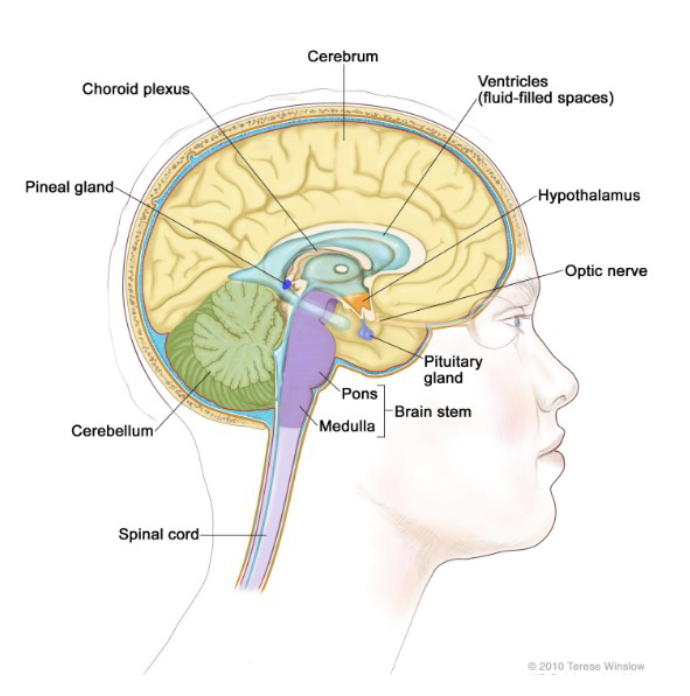
Pituitary Gland
“Master Gland” - it secretes hormones into the bloodstream that control the secretions of other endocrine glands (thyroid gland, adrenal cortex, mammary glands, ovaries and testes)
2 lobes - posterior and anterior
1 cm in diamater
Pituitary Gland
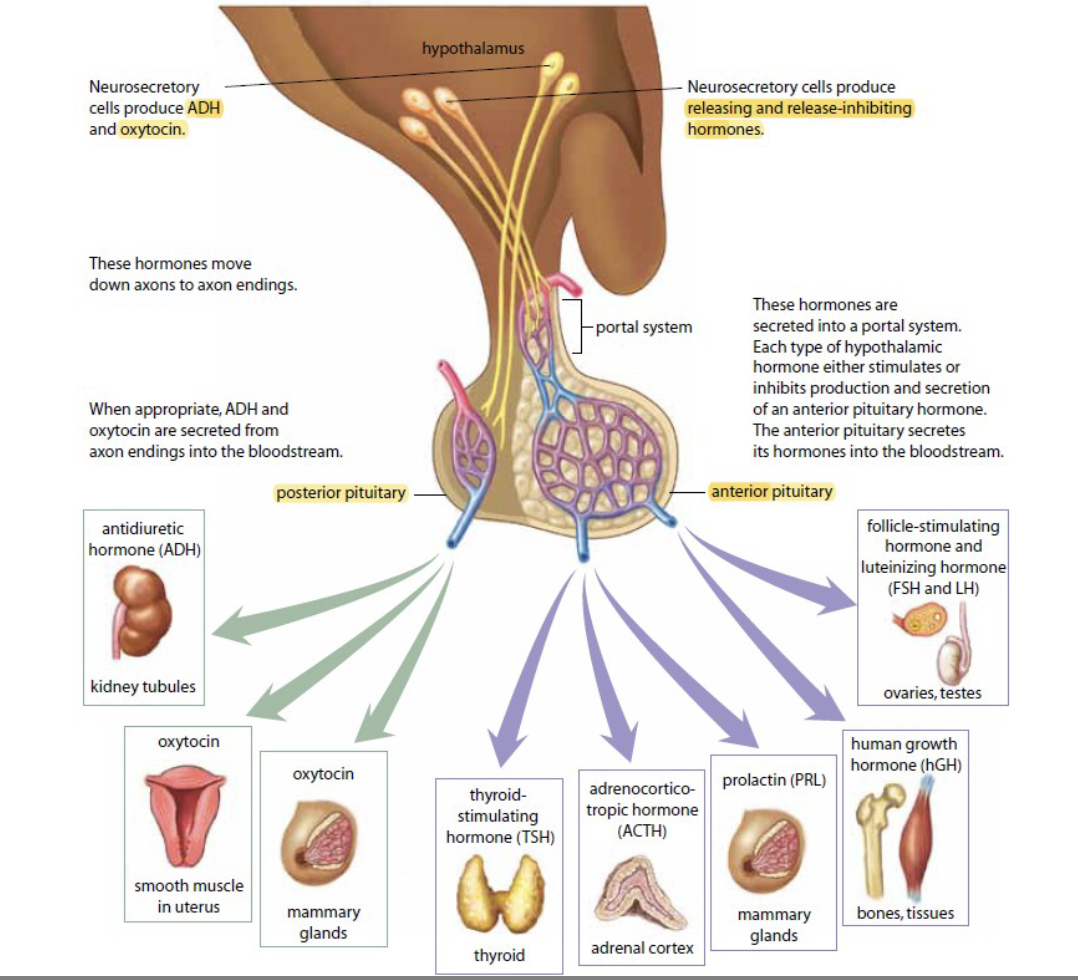
Posterior Pituitary
Part of the nervous system
Does NOT produce any hormones
Stores and releases antidiuretic hormone (ADH) and oxytocin - both produced in the hypothalamus and transferred to the posterior pituitary by neurons
Anterior Pituitary
Produces and releases 6 major hormones:
Thyroid-stimulating hormone (TSH) → targets thyroid gland
Adrenocorticotropic hormone (ACTH) → targets adrenal cortex
Prolactin (PRL) → targets mammary glands
Human growth hormone (hGH) → targets most cells (bones, tissues)
Follicle-stimulating hormone (FSH) → targets testes or ovaries
Luteinizing hormone (LH) → targets testes or ovaries
Hypothalamus sends message to anterior pituitary to stimulate/inhibit the release of hormones from this gland into the bloodstream
Human Growth Hormone (hGH)
Affects almost every body tissue by direct simulation or tropic effects
hGH stimulates liver to secrete growth factors which increase → protein synthesis, cell division and growth, and metabolic breakdown and release of fats stored in adipose tissue
Human Growth Hormone (hGH): Conditions
Gigantism: too much hGH secreted during childhood
Dwarfism: insufficient hGH production during childhood
Acromegaly: overproduction of hGH during adulthood (when skeletal growth is completed) bones and soft tissues widen
Thyroid Gland
Located below the larynx and on top of the trachea
Secretes immature thyroid hormones into the spaces between the cells of the thyroid gland
Ex. Thyroxine (T4) once functional, will be released into the bloodstream, where it increases the rate at which the body metabolizes fats, proteins and carbohydrates for energy.
T4 stimulates the cells of the heart, skeletal muscles, liver and kidneys to increase the rate of cellular respiration
Thyroid Gland
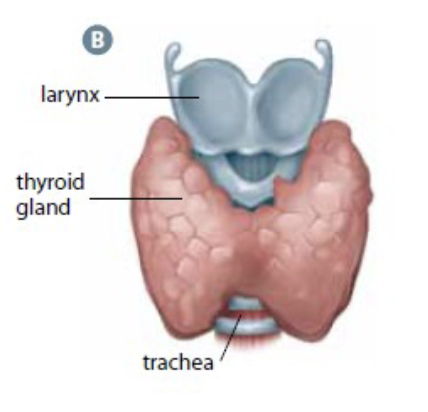
Thyroid Gland: Conditions
Hypothyroidism: failure of the thyroid to develop during childhood results in cretinism which results in low levels of T4.
Individuals are shorter than average, mental development delays
Adults with this condition will feel tired, have slow pulse rate, and slow metabolism
Thyroid Gland: Conditions
Hyperthyroidism: overproduction of T4 causes anxiety, insomnia, heat intolerance, irregular heartbeat and weight loss.
Graves disease (severe state) results in the immune system attacking the thyroid
Thyroid Gland: Conditions
Goitre: Iodine is required to make thyroid hormones
If I2 levels are low, T4 cannot be made and no messages are sent to the anterior pituitary
Enlargement of thyroid gland result in Goitre which causes difficulty to breath, swallow and cough
The Thyroid Gland and Calcitonin
Calcium is essential for healthy teeth/skeletal development
It plays a crucial role in blood clotting, nerve conduction and muscle contraction
If calcium levels are high, calcitonin is released and stimulates the uptake of calcium into the bones and lowering calcium levels in the blood
The Thyroid Gland and Calcitonin

Regulation of the thyroid gland by negative feedback
Thyroid stimulating hormone (TSH) is released by anterior pituitary gland, which causes the thyroid gland to secrete thyroxine (T4)
If T4 levels get too high, it signals the hypothalamus and anterior pituitary to decrease secretion of TSH which decrease T4 levels
Regulation of the thyroid gland by negative feedback

The Parathyroid Gland and parathyroid hormone (PTH)
If calcium levels are low in the blood, parathyroid hormone (PTH) is produced and stimulates:
Bone cells to break down bine material and secrete calcium into the blood
The kidneys reabsorb calcium from the urine, activating vitamin D in the process
Activated vitamin D stimulates the absorption of calcium from food in the intestines
→ all 3 of these processes increase the concentration of calcium in the blood back to normal levels
The Parathyroid Gland and parathyroid hormone (PTH)
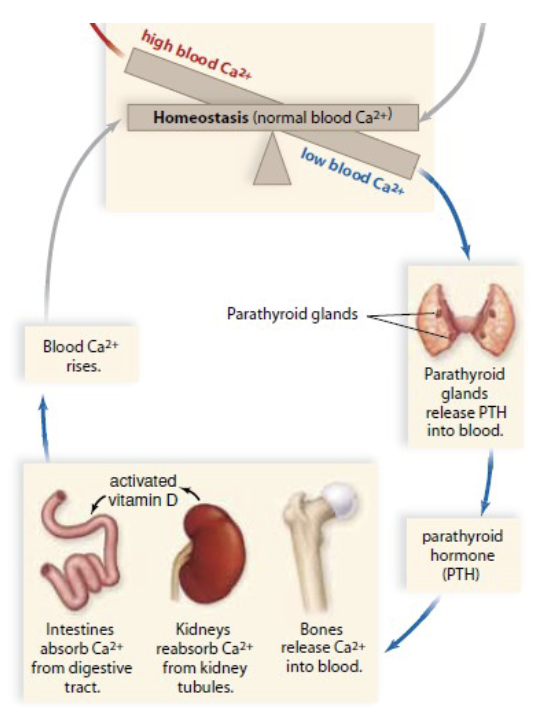
9.3 Hormonal Regulation of Stress response and Blood Sugar
Adrenal Glands
Located on top of the kidneys and are composed of two layers: Adrenal medulla (inner layer) and adrenal cortex (outer layer)
Adrenal Glands

Short term stress response
Heart rate and blood pressure increase
Blood flow to heart and muscles increases
Breathing rate increases
Blood glucose rises
Rate of cellular metabolism increases
Long term stress response
Kidney absorbs sodium ions and water, and blood volume and pressure increase
Protein and fat metabolism stimulated, which releases glucose
Inflammation is reduced and immune cells suppressed
Adrenal Medulla
Inner layer of adrenal gland
Regulates short term stress response
Produces epinephrine (adrenaline) and norepinephrine (noradrenaline) which have a similar response as stimulation of sympathetic nervous system
Regulates short term stress response/fight or flight response by increasing metabolism
In response to stress:
Sympathetic nervous system neurons send a signal from hypothalamus to adrenal medulla to produce epinephrine & norepinephrine
Causes increase in breathing rate, heart rate, blood
pressure, blood flow to the heart and muscles and conversion
of glycogen to glucose in the liver, pupils dilate, decrease of
blood to the extremities
Epinephrine acts quickly-therefore used in life- threatening conditions
Rapid release of the hormones since it is under nervous system control
Adrenal Cortex
Outer layer of adrenal gland
Regulates long-term stress response
Produces:
• Glucocorticoids (e.g. cortisol - increases blood sugar)
• Mineralocorticoids (e.g. aldosterone-increase blood pressure)
• Gonadocorticoids (small amounts of female & male sex hormones
Cortisol
Steroid hormone synthesized from cholesterol (glucocorticoid)
If DANGER sensed:
→ hypothalamus secretes a releasing hormone which
→ stimulates the anterior pituitary gland to secrete adrenocorticotropic hormone (ACTH) which
→ targets the adrenal cortex
→ releases cortisol
Causes an increase in blood glucose levels by promoting the breakdown of muscle protein into amino acids which get turned into glucose
Promotes break down of fat cells
Increased cortisol blood levels causes negative feedback on the hypothalamus and anterior pituitary
Acts as anti-inflammatory by suppressing the actions of the immune system
Sustained levels of cortisol can impair thinking, damage hear, increase blood pressure, lead to diabetes, increase susceptibility to infection, cause early death
Aldosterone
Mineralocorticoid
Stimulates kidneys to increase absorption of sodium into the blood, which increases the concentration of solutes in the blood which increases water retention in kidneys, increasing blood pressure
Conditions
Addison’s disease-inadequate secretion of mineralocorticoids and glucocorticoids causes hypoglycemia (low blood sugar), sodium & potassium imbalances, rapid weight loss, increased urine output, decrease in blood pressure, may be fatal in a few days if not treated.
Hormones of the Pancreas
Much of the pancreas secretes digestive enzymes into the small intestine, but it can also function as an endocrine gland.
→ Islets of Langerhans: pancreatic endocrine cells that secrete two antagonistic hormones:
Insulin-secreted by beta cells- job is to decrease the level of blood glucose
Glucagon-secreted by alpha cells- job is to increase the level of blood glucose
→ Both hormones are regulated by negative feedback mechanism
After Eating
Glucose moves from intestinal tract into the blood
Increases blood glucose levels
Beta cells secrete insulin, which circulates and acts on specific receptors to make the target cells more permeable to glucose
Especially effects muscle & liver cells where the glucose is converted into glycogen for storage, or other cells as an energy source
Once levels of glucose in the blood decrease so too does the insulin release.
Exercise/Fasting
• Decrease in blood glucose levels
• Alpha cells release glucagon
• Stimulates the liver to convert glycogen back into glucose which moves into the blood
The Effects of Glucose Imbalance
Diabetes mellitus:
• serious chronic condition that results when the pancreas does not make enough insulin or the body does not respond properly to insulin
• Levels of blood glucose tend to rise after meals, called hyperglycemia, or high blood sugar
• Without insulin, cells remain impermeable to glucose and cells become starved for glucose
• The body compensates to some degree by switching to protein and fat
metabolism for energy
• Fat metabolism releases ketones, a toxic byproduct and can lead to
ketoacidosis (can be life-threatening)
Effects of Diabetes Mellitus:
Kidneys are incapable of reabsorbing all the glucose that is filtered through them from the blood, therefore glucose is excreted in the urine
Large volumes of water follow the glucose into the urine and get excreted
People with untreated diabetes experience low energy, thirst, produce large volumes of glucose-rich urine
Longer effects can lead to blindness, kidney failure, nerve damage, gangrene (a severe infection) in the limb
Causes of Diabetes Mellitus:
There are 2 types of diabetes:
→ Type 1 diabetes (also called juvenile diabetes and insulin-dependent diabetes
→ Type 2 diabetes (also called adult-onset or non-insulin-dependent diabetes
Type 1 diabetes:
The immune system produces antibodies that attack and destroy the beta cells of the pancreas (cells that produce insulin)
Must have daily insulin injections in order to live
Type 2 diabetes:
The insulin receptors on the body’s cells stop responding to insulin and the beta cells of the pancreas produce less insulin over time
People who are overweight have a greater chance of developing type 2 diabetes
Can often be controlled with diet, exercise and oral medication
9.4 Hormonal Regulation of the Reproductive System
Gonads
The organs that produce reproductive cells (sperm & egg) or gametes.
Produce sex hormones- which are the chemical compounds that control the development and function of the reproductive system
Parts of the Male Reproductive System
Testes → seminiferous tubules - produce sperm (about 250m of tubules) and can produce more than 100 million sperm/day
interstitial cells (in between the tubules)- produce testosterone-sperm then move to epididymis which is connected to a storage duct called the ductus deferens, which leads to-penis
Penis →Transfers sperm from male to female reproductive tract. Used for reproduction and urinary waste purposes
Seminal Fluid → (combination of fluid from seminal vesicles, prostate gland & Cowper's gland + sperm = semen)
Parts of the Male Reproductive System
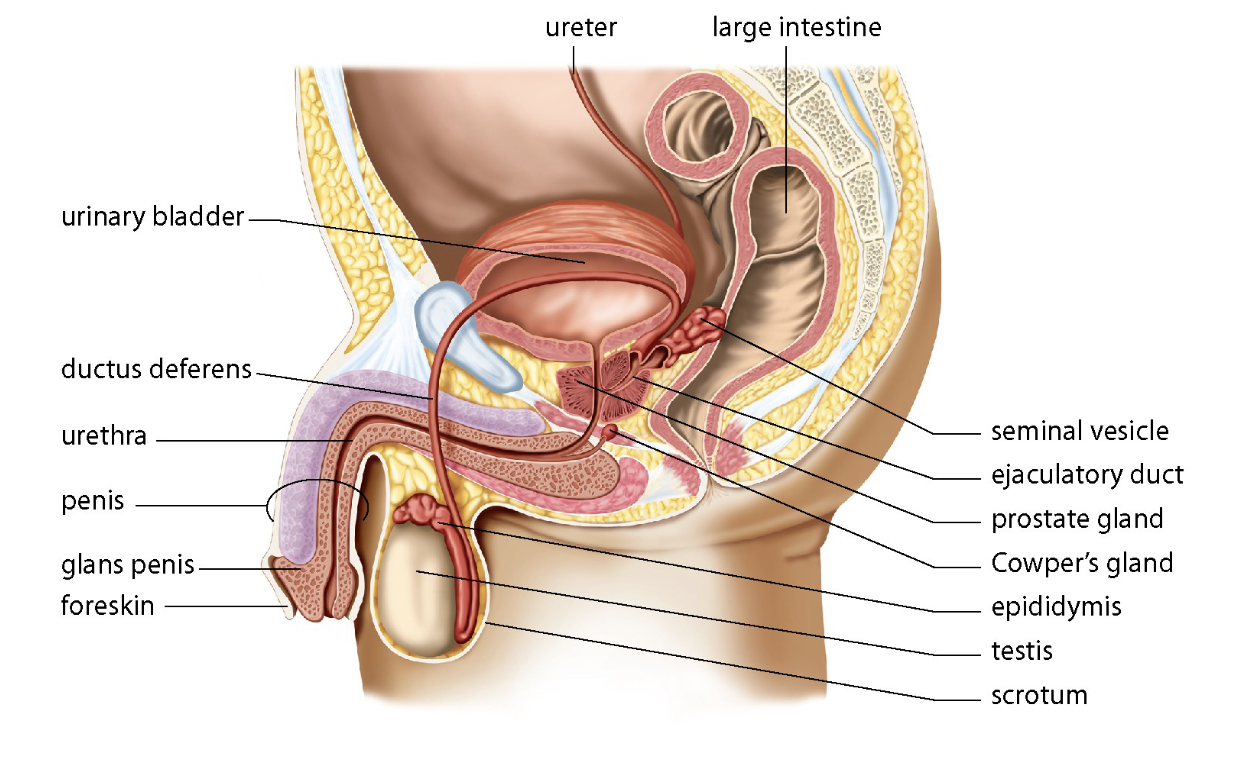
Sex Hormones and the Male Reproductive System
Development of male sex organs begins before birth.
Y chromosome carries a gene called TDF (testis- determining factor), which leads to production of male sex hormones (androgens). This initiates development of male sex organs and ducts in fetus.
Testis originate in abdominal cavity → then move down.
Puberty: 10-13 years old
Hypothalamus increases production of GnRH (gonadotropin-releasing hormone) → goes to anterior pituitary gland releases FSH & LH (follicle stimulating hormone and luteinizing hormone).
These hormones cause the testes to produce sperm and release testosterone.
Testosterone acts on various tissues to complete development of sex organs & sexual characteristic
Sex Hormones and the Male Reproductive System - REGULATION
FSH: Causes the seminiferous tubules to produce sperm &
release inhibin.
→ Inhibin acts on anterior pituitary to inhibit production of FSH (neg. feedback loop), as FSH drops, testes release less inhibin, therefore anterior pituitary releases more FSH, -therefore constant sperm production over time.
LH: Causes interstitial cells in testes to release testosterone. Testosterone promotes changes such as muscle development and formation of facial hair, and it acts on anterior pituitary to inhibit release of LH (neg. feedback loop).
→ Anabolic Steroids mimic action of testosterone in promoting muscle development… but disrupt reproductive hormone feedback system-shrinking testes, low sperm count and development of breast
How does aging affect the male reproductive system?
Decline in testosterone at 40 (andropause) may be linked to symptoms such as fatigue, depression, loss of muscle and bone mass, decrease in sperm production.
Low doses of testosterone can help.
Prostate gland can get bigger. This leads to discomfort, urinary difficulties, can increase cancer risk.
Parts of the Female Reproductive System
Ovaries: Two gonads contain the ova and connected to the uterus via the fallopian tubes. Each ovary has a follicle, where the singular ovum develops. Responsible for releasing a mature ovum (via cilia in the oviduct), to begin its journey to the uterus. Fallopian tubes is the site of fertilization.
Uterus: Pear-shaped muscular organ. Inside it contains a lining made of layers of tissue designed to house and nurture the fertilized egg when it implants. If implantation does not occur the lining sheds. The opening of the uterus is called the cervix, this connects it to the birth canal (vagina).
Vagina: Where the female reproductive system opens to the outside also known as the birth canal (where the fetus exits)
Parts of the Female Reproductive System

Parts of the Female Reproductive System
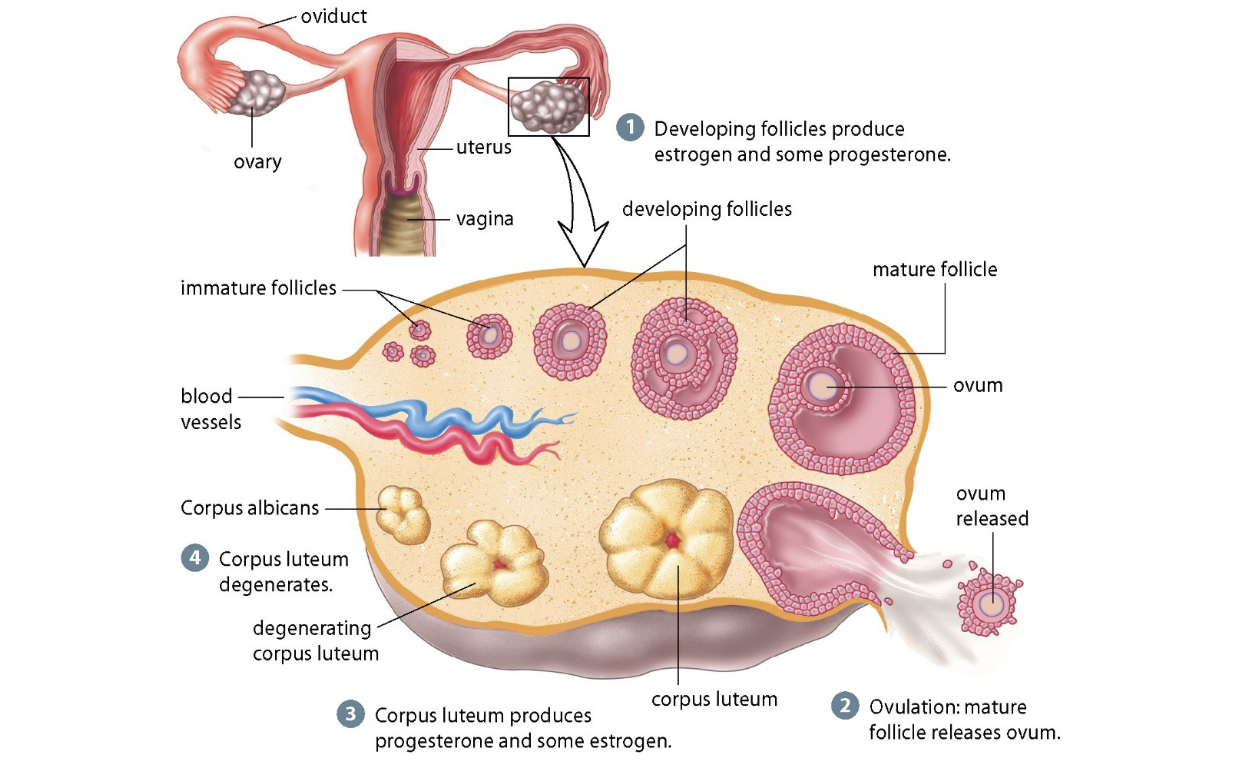
Sex Hormones and the Female Reproductive System
Hypothalamus produces GnRH at puberty (9-13 years old), and causes anterior pituitary to release LH & FSH →
These hormones act on the ovaries to produce estrogen & progesterone - stimulate development of female secondary sex characteristics and launch a reproductive cycle until about mid age
The Menstrual Cycle
Period of roughly 28 days which hormones stimulate development of uterine lining, and egg released from ovary. If egg is not fertilized, uterine lining is shed (along with unfertilized egg)
Split into 2 separate but interconnected cycles (occurring at the same time)
1) Ovarian Cycle → in the ovaries
2) Uterine Cycle → in the uterus
End result is that mature follicles release an ovum, so it is ready to be fertilized. At the same time, the uterus is preparing itself for the implantation of an egg
Ovarian Cycle
Girls are born with 2 million follicles, 400k survive puberty, and 400 will mature and become an ovum (egg).
Ovarian Cycle in 2 Stage
Follicular stage → inc. in the level of FSH – stimulates one follicle to mature, it releases estrogen and some progesterone. This acts on the anterior pituitary to inhibit release of FSH.
At same time estrogen triggers a sudden release of GnRH from hypothalamus, this leads to a sharp inc. in LH production from anterior pituitary -triggering ovulation - follicle bursts releasing the ovum.
Ovulation ends the follicular stage
Luteal stage - once ovum released, LH causes follicle to develop into Corpus Luteum → secretes progesterone and some estrogen. As levels of these hormones inc. in blood, they act on anterior pituitary to inhibit FSH & LH production. The Corpus Luteum degenerates, leading to a dec. in Estrogen & Progesterone, the low levels in blood cause anterior pituitary to inc. FSH & cycle begins again.
if ovum fertilized- and implants in endometrium, blood levels of Estrogen & Progesterone remain high under stimulus of hormones released by embryo-supporting membrane. The continued presence of progesterone maintains the endometrium to support the developing fetus
Uterine cycle
Begins on first day of menstruation - also first day of ovarian cycle-
Corpus Leuteum has degenerated and levels of sex hormones in blood are low.
Menstruation lasts for first 5 days of uterine cycle and by end endometrium (lining of the uterus) is very thin.
As a new follicle begins to mature, and release Estrogen (inc. in blood) ~6th day of uterine cycle, Estrogen level is high enough to cause the endometrium to begin thickening.
After ovulation, release of Progesterone by Corpus Luteum causes a more rapid thickening of endometrium. Between day 15 and 23 of cycle, thickness of endometrium may double or even triple.
If fertilization doesn’t occur, Corpus Luteum degenerates, dec. sex hormones, endometrium breaks down and menstruation begins again
How does aging affect the female reproductive system?
Number of viable follicles decreases with age, leading to a decrease in estrogen and progesterone
Menstrual cycle becomes irregular at this point, and then stops altogether, known as menopause. This takes place around 50 years old.
No ova produced anymore, dec. in sex hormones leads to: hot flashes, mood changes, rising cholesterol levels, diminishing bone mass, inc. risk of uterine cancer, breast cancer and heart disease
What is the purpose of HRT? What are some of the issues associated
with it?
Low estrogen doses with or without Progesterone can ease symptoms of menopause
Risks: Inc. coronary heart disease, strokes and blood clots, inc. risk of breast & colorectal cancer, inc. risk of dementia